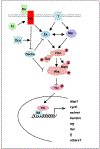Hippo signaling pathway and organ size control - PubMed (original) (raw)
Review
Hippo signaling pathway and organ size control
Lei Zhang et al. Fly (Austin). 2009 Jan-Mar.
Abstract
Initially discovered in Drosophila, the Hippo (Hpo) pathway has been recognized as a conserved signaling pathway that controls organ size during development by restricting cell growth and proliferation and by promoting apoptosis. In addition, abnormal activities of several Hpo pathway components have been implicated in human cancer. Here, we review the current understanding of the molecular and cellular basis of Hpo signaling in development and tumorigenesis, and discuss how the Hpo pathway integrates spatial and temporal signals to control tissue growth and organ size.
Figures
Figure 1. hop or wts mutant clones lead to tumor-like growth in mosaic flies
Wild type eye (A) or enlarged eye carrying hpo mutant clones (B_). wts_ mutant clones (arrows) located on the notum resulted in tumor-like growth (C). Adapted from Jia et al.
Figure 2. The Drosophila Hpo pathway
The Hpo kinase cascade consists of four core proteins: Hpo, Sav, Wts, and Mats. Sav binds and regulates Hpo. Hpo phosphorylates and activates Wts. Hpo also phosphorylates Mats to enhance its ability to activate Wts. Wts phosphorylates Yki and restricts its nuclear localization. Yki forms a complex with Sd to activate Hpo target genes. Ex and Mer act in a partially redundant manner to regulate the Hpo kinase cascade. Fat is a candidate receptor and may regulate the Hpo pathway through Dachs and Ex. Ds is a candidate ligand for Fat. Fj modulates Ds/Fat interaction through phosphorylating Ds and Fat in the Golgi.
Similar articles
- Ajuba LIM proteins are negative regulators of the Hippo signaling pathway.
Das Thakur M, Feng Y, Jagannathan R, Seppa MJ, Skeath JB, Longmore GD. Das Thakur M, et al. Curr Biol. 2010 Apr 13;20(7):657-62. doi: 10.1016/j.cub.2010.02.035. Epub 2010 Mar 18. Curr Biol. 2010. PMID: 20303269 Free PMC article. - The TEAD/TEF family of transcription factor Scalloped mediates Hippo signaling in organ size control.
Zhang L, Ren F, Zhang Q, Chen Y, Wang B, Jiang J. Zhang L, et al. Dev Cell. 2008 Mar;14(3):377-87. doi: 10.1016/j.devcel.2008.01.006. Epub 2008 Feb 7. Dev Cell. 2008. PMID: 18258485 Free PMC article. - The TEAD/TEF family protein Scalloped mediates transcriptional output of the Hippo growth-regulatory pathway.
Wu S, Liu Y, Zheng Y, Dong J, Pan D. Wu S, et al. Dev Cell. 2008 Mar;14(3):388-98. doi: 10.1016/j.devcel.2008.01.007. Epub 2008 Feb 7. Dev Cell. 2008. PMID: 18258486 - Regulation of organ size: insights from the Drosophila Hippo signaling pathway.
Kango-Singh M, Singh A. Kango-Singh M, et al. Dev Dyn. 2009 Jul;238(7):1627-37. doi: 10.1002/dvdy.21996. Dev Dyn. 2009. PMID: 19517570 Review. - [Developmental control of organ growth by the Hippo pathway].
Bardet PL. Bardet PL. Med Sci (Paris). 2009 Mar;25(3):253-7. doi: 10.1051/medsci/2009253253. Med Sci (Paris). 2009. PMID: 19361388 Review. French.
Cited by
- Snapshots of a hybrid transcription factor in the Hippo pathway.
Luo X. Luo X. Protein Cell. 2010 Sep;1(9):811-9. doi: 10.1007/s13238-010-0105-z. Epub 2010 Oct 7. Protein Cell. 2010. PMID: 21203923 Free PMC article. Review. - Comparative transcriptomes analysis of the wing disc between two silkworm strains with different size of wings.
Zhang J, Blessing D, Wu C, Liu N, Li J, Qin S, Li M. Zhang J, et al. PLoS One. 2017 Jun 15;12(6):e0179560. doi: 10.1371/journal.pone.0179560. eCollection 2017. PLoS One. 2017. PMID: 28617839 Free PMC article. - The cell adhesion molecule echinoid functions as a tumor suppressor and upstream regulator of the Hippo signaling pathway.
Yue T, Tian A, Jiang J. Yue T, et al. Dev Cell. 2012 Feb 14;22(2):255-67. doi: 10.1016/j.devcel.2011.12.011. Epub 2012 Jan 25. Dev Cell. 2012. PMID: 22280890 Free PMC article. - Control of mitochondrial structure and function by the Yorkie/YAP oncogenic pathway.
Nagaraj R, Gururaja-Rao S, Jones KT, Slattery M, Negre N, Braas D, Christofk H, White KP, Mann R, Banerjee U. Nagaraj R, et al. Genes Dev. 2012 Sep 15;26(18):2027-37. doi: 10.1101/gad.183061.111. Epub 2012 Aug 27. Genes Dev. 2012. PMID: 22925885 Free PMC article. - NPHP4, a cilia-associated protein, negatively regulates the Hippo pathway.
Habbig S, Bartram MP, Müller RU, Schwarz R, Andriopoulos N, Chen S, Sägmüller JG, Hoehne M, Burst V, Liebau MC, Reinhardt HC, Benzing T, Schermer B. Habbig S, et al. J Cell Biol. 2011 May 16;193(4):633-42. doi: 10.1083/jcb.201009069. Epub 2011 May 9. J Cell Biol. 2011. PMID: 21555462 Free PMC article.
References
- Conlon I, Raff M. Size Control in Animal Development. Cell 1999; 96:235–44. - PubMed
- Hariharan IK, Bilder D. Regulation of imaginal disc growth by tumor-suppressor genes in Drosophila. Annual review of genetics 2006; 40:335–61. - PubMed
- Bryant PJ, Simpson P. Intrinsic and extrinsic control of growth in developing organs. Q Rev Biol 1984; 59:387–415. - PubMed
- Bryant PJ, Levinson P. Intrinsic growth control in the imaginal primordia of Drosophila, and the autonomous action of a lethal mutation causing overgrowth. Developmental biology 1985; 107:355–63. - PubMed
- Bryant PJ, Huettner B, Held LJ, Ryerse J, Szidonya J. Mutations at the fat locus interfere with cell proliferation control and epithelial morphogenesis in Drosophila. Developmental biology 1988; 129:541–54. - PubMed
Publication types
MeSH terms
Substances
LinkOut - more resources
Full Text Sources
Molecular Biology Databases

